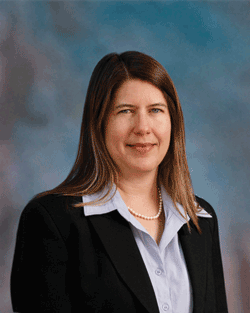While suppliers and users want to see the MEMS territory prosper, each group has different views on how to do it
BY KAREN LIGHTMAN
Managing Director
MEMS Industry Group
www.MEMSindustrygroup.org
Both electronics OEMs and their customers have conflicting feelings about standardization, in general, that have resulted in some lively dialogues over the issue. There were, for example, some interesting exchanges during the panels of the MEMS track at this year’s Sensors Expo.

Those exchanges brought to mind a song from Rodgers & Hammerstein’s Oklahoma! , namely, “The Farmer and the Cowman Should Be Friends,” in which the farmers and ranchers disparate goals are exposed. The farmers want to fence their land to protect their crops from cattle; the “cowmen,” or cattle ranchers, want their animals to have “free range” over the land. Like the farmers, MEMS suppliers typically want to protect their IP through proprietary processes, while, like the cowmen, OEMs want the openness needed to work with multiple suppliers, even competitors, to achieve economy of scale and fast time to market.
Varying viewpoints
Depending on whether you are a “farmer” or a “rancher,” you may see standardization in its various implementations as either a:
Means to simplify component selection, design-in, and sourcing. or Limit to innovation, differentiation, and competitive positioning.
To get a broader perspective, we asked some industry leaders for their views on the topic.
When asked for a “wish list” of what he would consider progress in standardization, Steve Whalley, director for Sensors at Intel’s Architecture Group, answered: “basics.” Whalley “would like to see MEMS products adhere to common guidelines on how parameters are tested, validated, calibrated and, ultimately, specified in data sheets.”

Intel’s Steve Whalley “would like to see MEMS products adhere to common guidelines … ultimately, specified in data sheets.”
Jeannette Wilson, product line manager for Consumer and Industrial Sensors at Freescale Semiconductor, seconded Whalley’s view. Wilson would like standards “for measuring and specifying algorithm performance.” She added that “it should be possible to compare multiple algorithms via their datasheet, noting that the data sheet is “low-hanging fruit.”
It’s easy to make high-level statements about the virtue of basics, but how does that translate into specifics? Rob O’Reilly, senior member of the technical staff in the MEMS and Sensors Technology Group at Analog Devices, said that it will start with parameters such as offset, sensitivity, and output protocols, and added that there is already momentum around the latter (I2 S, I2 C, SPI, and others), as well as operating voltage, FIFO structure, and data rates. This effort yields immediate benefits for the customers, of course, noted Whalley, since it allows them to compare products from various vendors on an “apples to apples” basis.
But specifications alone don’t tell the story, said James Clardy, technology strategist at Dell, Inc., who wants to see relative performance in actual “use cases” that emulate real-world applications, not just specs.

For Dell’s James Clardy, specifications alone don’t tell the story.
The ‘Origin of the Standards’
These standards are developed by efforts of both OEM groups as well as their customers. For the early mass-market MEMS devices of airbag crash sensors, automotive OEMs adopted the AEQC (Advanced Engine Quality Control) standards for airbag operation and had the clout to get their MEMS suppliers to follow them.
The more volatile and faster-moving consumer market is seeing similar pressures, but large OEMs “will most likely never agree,” said ADI’s O’Reilly, because they want to preserve a level of differentiation in a very competitive environment. Also, the inherently different nature of consumer markets means that the customers haven’t settled on a consistent set of preferences. Consumer preferences are always going to be fickle, trendy and changing often.”

ADI’s Rob O’Reilly thinks large OEMs in the consumer market “will most likely never agree” to standards.
Now, even operating system vendors are becoming factors. Dell’s Clardy notes that, with Windows 8, Microsoft has become the first major OS vendor to specify a certification for sensor suppliers (see sysdev.microsoft.com/en-US/Hardware/lpl/). Also, as OEMs are packing more sensors into their products, such as tablets and smartphones, he added that sensor-fusion algorithms, which derive additional parameters by combining values from the raw sensor data, are becoming critical differentiators for MEMS suppliers.
The fusion aspect was reiterated by Wilson of Freescale, where “MEMS providers can each have different sensor-fusion algorithms, but need an architecture specification outlining a common API to allow the fusion to be used in Windows 8 or Android solutions.” This level of fusion extends upward, as lower-level functions may need to pass along details such as error-covariance, to assess optimal tradeoffs at higher levels.
Where are we today?
Given the incentives for standardization, where do things stand now? There is activity from many sources in the industry, all doing their best to work collaboratively. MEMS Industry Group (MIG) began partnering with the National Institute of Standards and Technology (NIST) several years ago to identify and document device-level qualification and testing needs. The result was a report containing recommendations and an action plan for next steps. (The executive summary is available in the MIG Resource Library.)
Putting it in writing
As a neutral forum advancing MEMS across global markets, MIG is currently working with its partners and members to advance one of these action items: the standardization of data sheets for MEMS inertial sensors. Other groups in and around the MEMS industry are also making strides: the IEEE via terms and standards for inertial sensors; the MIPI Alliance with hardware and software interfaces for mobile devices; the International Electronics Manufacturing Initiative (iNEMI) through its MEMS technology roadmap; and Khronos by providing APIs via the StreamInput effort.
Intel’s Whalley said that while there is more incentive to move on this as MEMS increasingly becomes mainstream, the efforts are still in the early stages. Some of these efforts are focused on non-electrical details, with OEMS initially asking for first steps on device packaging and pin-outs to support their need for smaller, thinner form factors and multi-vendor commonality.
At some level, the movement toward standardization is in the early stages. In one approach, noted Whalley, a strong, aggressive vendor will take a leadership position and hope that competitors will follow, or that an industry-wide group will come on board. Another approach is for smaller companies to band together and try to set up a standard via the IEEE or MIG collaboration. As with most engineering decisions, each method has its tradeoffs with respect to time to execute, feasibility, adoption, certification, and compliance policies, he added.
There’s more to a practical set of standards, of course. Wilson pointed out that “there needs to be a balance between the rigors of standardization and the flexibility for differentiation.” Just minimum levels of specification criteria will not be sufficient.

Freescale’s Jeannette Wilson says, “Tthere needs to be a balance between the rigors of standardization and the flexibility for differentiation.”
As MEMS takes on more diverse applications, Dell’s Clardy clarified the broader environment that success brings in dealing with supply-chain management, including MEMS from different vendors, processors, platforms and form factors. So, he asks, how do you still add value that consumers will actually pay for, without tying yourself into knots? That’s part of the challenge and dilemma.
Perhaps standards’ development will morph, as ADI’s O’Reilly speculates, with a “split” in efforts, just as there often is for other components. For the higher-performance, feature-rich devices, “this [standardization] will never happen” but for lower-performance, commodity-level devices, “there is a greater probability that standards could be adopted.” He noted that large OEMs always try to preserve some level of differentiation, with the slightly longer product-life cycle of higher-end consumer products supporting this tendency.
So perhaps the end-goal will be that bits and pieces of standardization can adapt to this diverse range of MEMS, much like the cattlemen and farmers were eventually able to find some semblance of peace in Oklahama! Here’s hoping, anyhow. ■
Advertisement
Learn more about MEMS Industry Group





